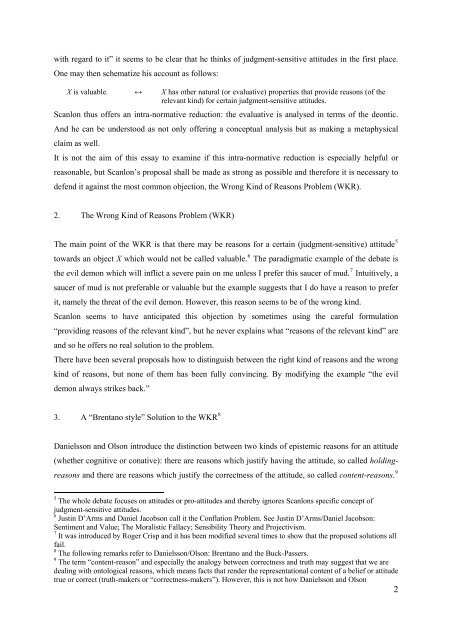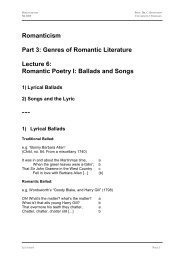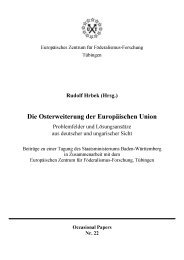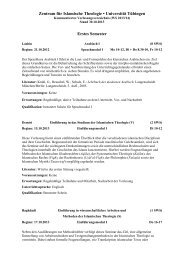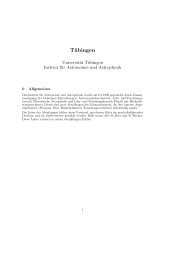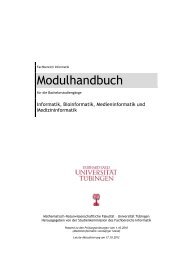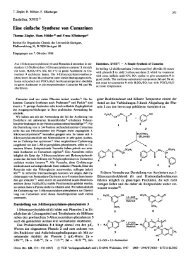Eberhard Karls Universität Tübingen
Eberhard Karls Universität Tübingen
Eberhard Karls Universität Tübingen
Create successful ePaper yourself
Turn your PDF publications into a flip-book with our unique Google optimized e-Paper software.
with regard to it” it seems to be clear that he thinks of judgment-sensitive attitudes in the first place.<br />
One may then schematize his account as follows:<br />
X is valuable. ↔ X has other natural (or evaluative) properties that provide reasons (of the<br />
relevant kind) for certain judgment-sensitive attitudes.<br />
Scanlon thus offers an intra-normative reduction: the evaluative is analysed in terms of the deontic.<br />
And he can be understood as not only offering a conceptual analysis but as making a metaphysical<br />
claim as well.<br />
It is not the aim of this essay to examine if this intra-normative reduction is especially helpful or<br />
reasonable, but Scanlon’s proposal shall be made as strong as possible and therefore it is necessary to<br />
defend it against the most common objection, the Wrong Kind of Reasons Problem (WKR).<br />
2. The Wrong Kind of Reasons Problem (WKR)<br />
The main point of the WKR is that there may be reasons for a certain (judgment-sensitive) attitude 5<br />
towards an object X which would not be called valuable. 6 The paradigmatic example of the debate is<br />
the evil demon which will inflict a severe pain on me unless I prefer this saucer of mud. 7 Intuitively, a<br />
saucer of mud is not preferable or valuable but the example suggests that I do have a reason to prefer<br />
it, namely the threat of the evil demon. However, this reason seems to be of the wrong kind.<br />
Scanlon seems to have anticipated this objection by sometimes using the careful formulation<br />
“providing reasons of the relevant kind”, but he never explains what “reasons of the relevant kind” are<br />
and so he offers no real solution to the problem.<br />
There have been several proposals how to distinguish between the right kind of reasons and the wrong<br />
kind of reasons, but none of them has been fully convincing. By modifying the example “the evil<br />
demon always strikes back.”<br />
3. A “Brentano style” Solution to the WKR 8<br />
Danielsson and Olson introduce the distinction between two kinds of epistemic reasons for an attitude<br />
(whether cognitive or conative): there are reasons which justify having the attitude, so called holdingreasons<br />
and there are reasons which justify the correctness of the attitude, so called content-reasons. 9<br />
5<br />
The whole debate focuses on attitudes or pro-attitudes and thereby ignores Scanlons specific concept of<br />
judgment-sensitive attitudes.<br />
6<br />
Justin D’Arms and Daniel Jacobson call it the Conflation Problem. See Justin D’Arms/Daniel Jacobson:<br />
Sentiment and Value; The Moralistic Fallacy; Sensibility Theory and Projectivism.<br />
7<br />
It was introduced by Roger Crisp and it has been modified several times to show that the proposed solutions all<br />
fail.<br />
8<br />
The following remarks refer to Danielsson/Olson: Brentano and the Buck-Passers.<br />
9<br />
The term “content-reason” and especially the analogy between correctness and truth may suggest that we are<br />
dealing with ontological reasons, which means facts that render the representational content of a belief or attitude<br />
true or correct (truth-makers or “correctness-makers”). However, this is not how Danielsson and Olson<br />
2


